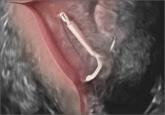Article

How to identify and localize IUDs on ultrasound
ObGyns—many of whom have access only to 2D ultrasound—are increasingly called upon to determine the positioning, or malpositioning, of the device...
Steven R. Goldstein, MD, and Chrystie Fujimoto, MD
Dr. Goldstein is Professor of Obstetrics and Gynecology, New York University Langone Medical Center, New York. He serves on the OBG Management Board of Editors.
Dr. Fujimoto is Assistant Clinical Professor of Obstetrics and Gynecology, University of Hawaii John A. Burns School of Medicine, Honolulu.
Dr. Goldstein reports that he has an equipment loan from Philips, and is President of the American Institute of Ultrasound in Medicine (AIUM). Dr. Fujimoto reports that she is a partner in Malama Imaging, LLC.

START using more accurate 3D ultrasound instead
Several decades ago, the negative publicity associated with the Dalkon Shield brand of intrauterine device (IUD) caused a decline in the use of this form of long-acting reversible contraception (LARC). However, there has been a resurgence in the use of IUDs in the past few years;1 the current opinion of the American College of Obstetricians and Gynecologists encourages first-line use of LARC, and the IUD is popular with patients.2
Related articles:
Let's increase our use of IUDs and improve contraceptive effectiveness in this country. Robert L. Barbieri, MD (Editorial; August 2012)
5 IUD myths dispelled. Anne A. Moore, DNP, APN (September 2-13)
Some patients with IUDs will experience more painful periods, intramenstrual cramps or bleeding, or heavier menses. Until recently, many clinicians (including us) believed these possible adverse effects were not unexpected and often warned patients that it was not abnormal if one or more of these occurred.
More recently, however, results of an important study showed that patients with part of their IUD not totally located within the endometrial cavity (eg, protruded into the cervix or partially piercing the myometrium) had an increased rate of pain and bleeding.3 Of patients with any abnormally located part of their IUD, 36% had abnormal bleeding and 39% had pain, compared with 15% of women who reported abnormal bleeding and 19% who reported pain when their IUD was totally positioned within the endometrial cavity (P = .02 and .03, respectively).
Related article: Malpositioned IUDs: When you should intervene (and when you should not). Kari Braaten, MD, MPH, and Alisa B. Goldberg, MD, MPH (August 2012)
A 3D ultrasound can reveal malpositioning not identified on 2D
Prior to the widespread availability of ultrasonography, some practitioners will remember placing a sound in the uterus taped to a tenaculum and obtaining a flat plate and cross table lateral abdominal x-ray to ensure an IUD was indeed “intrauterine.” With the advent of transvaginal ultrasonography, a long-axis view with a centrally located IUD was thought to definitively locate the device as intrauterine (FIGURES 1A, 2A, AND 3A).
Related articles:
How to identify and localize IUDs on ultrasound. Michelle Stalnaker, MD, and Andrew Kaunitz, MD (Images in GYN ultrasound; August 2014)
Update on Contraception. Melissa Chen, MD, MPH, and Mitchell Creinin, MD (August 2014)
Now, with the advent of 3D transvaginal ultrasonography and the ability to construct a coronal plane, some IUDs, which appear to be totally normal on 2D sonography, actually show an arm that pierces the myometrium or protrudes into the cervix (FIGURES 1B, 2B, AND 3B). This in fact is probably the location that must exist at insertion for so-called “migration” to occur through the myometrium as uterine contractions, especially with menses, occur.
So the next time a patient with an IUD reports pain or bleeding, STOP doing only 2D ultrasound and START obtaining a 3D coronal reconstructive view.
WE WANT TO HEAR FROM YOU! Share your thoughts on this article. Send your Letter to the Editor to: rbarbieri@frontlinemedcom.com

ObGyns—many of whom have access only to 2D ultrasound—are increasingly called upon to determine the positioning, or malpositioning, of the device...
When it comes to the morning-after pill, physicians need a wake-up call
The unintended pregnancy rate is too high in the United States, and the use of long-acting reversible contraceptives is too low. Expanding the...

Contraception now is covered for most insured patients, but two cases before the Supreme Court could unravel this new guarantee
This overview of vessel-sealing devices for laparoscopic procedures should help you select a system that meets the particular needs of your...

Why we have not yet reduced the unintended pregnancy rate


Although it is gaining popularity in the United States, the IUD is often overlooked as a contraceptive option because of several common...
Highlights (and lowlights) from the past year in contraception: the US unintended pregnancy rate and controversies in providing contraception.
